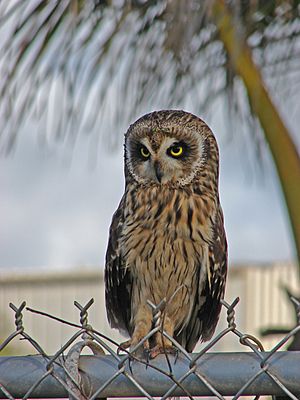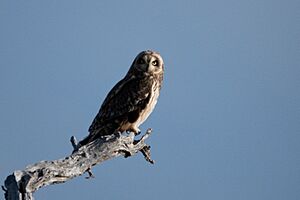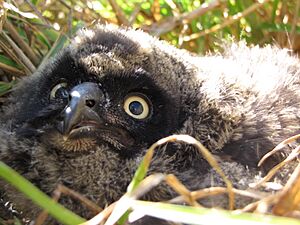Pueo facts for kids
Quick facts for kids Pueo |
|
|---|---|
 |
|
| Conservation status | |
| Scientific classification |
|
| Kingdom: | Animalia |
| Phylum: | Chordata |
| Class: | Aves |
| Order: | Strigiformes |
| Family: | Strigidae |
| Genus: | Asio |
| Species: | |
| Subspecies: |
A. f. sandwichensis
|
| Trinomial name | |
| Asio flammeus sandwichensis A. Bloxam, 1827
|
|
| Synonyms | |
|
|
The pueo (Asio flammeus sandwichensis) is a special type of short-eared owl. It is an owl that lives only in Hawaii.
Contents
About the Pueo Owl
The pueo is a unique owl found in Hawaii. It is a subspecies, which means it's a specific kind of short-eared owl that has adapted to life on the Hawaiian islands.
What Does the Pueo Look Like?
This owl has long wings and a short tail. Its feathers can be different shades of brown and gray. Pueo owls are about 13 to 17 inches long. One of the most striking things about them is their bright yellow eyes.
Where Do Pueo Owls Live?
Pueo owls live in forests and grassy areas all over the Hawaiian islands. However, recent studies show that their numbers are going down. This is especially true on Oʻahu, an island where they used to be very common. The pueo is now considered an endangered species, meaning it is at risk of disappearing forever.
What Do Pueo Owls Eat?
Pueo owls mostly eat small mammals. This includes mice, rats, and rabbits. They are very good at finding their prey from far away because of their large eyes.
They usually hunt at night. Their amazing night vision helps them fly easily through thick forests. When a pueo sees an animal, it glides down quietly and lands right on top of it. This kills the prey quickly, and then the owl flies away without a sound. Pueo owls can also eat insects and reptiles.
History of the Pueo
Scientists believe the pueo arrived in Hawaii after the Polynesians did. This means they came to the islands relatively recently. Their arrival might be connected to the Polynesian rat (Rattus exulans). These rats were brought to the islands by humans.
Dangers to Pueo Owls
Pueo owls build their nests on the ground. This makes their eggs and young owls easy targets for predators. Animals like the small Indian mongoose, which were brought to Hawaii by people, hunt young owls and their eggs.
Pueo owls are also affected by bright lights at night, known as light pollution. Sadly, they are often hit by cars and killed.
Sick Owl Syndrome
Pueo owls seem to be somewhat strong against avian malaria. This disease has harmed many other native Hawaiian birds. However, pueo owls have recently been affected by a mysterious illness called "sick owl syndrome," or SOS.
When owls have SOS, many of them are found walking around confused on roads. This often leads to them being hit by cars and dying. Scientists are not sure what causes sick owl syndrome. They think it might be from pesticides, especially poisons used to kill rodents. But it could also be caused by a germ, confusion from bright lights, or other reasons.




